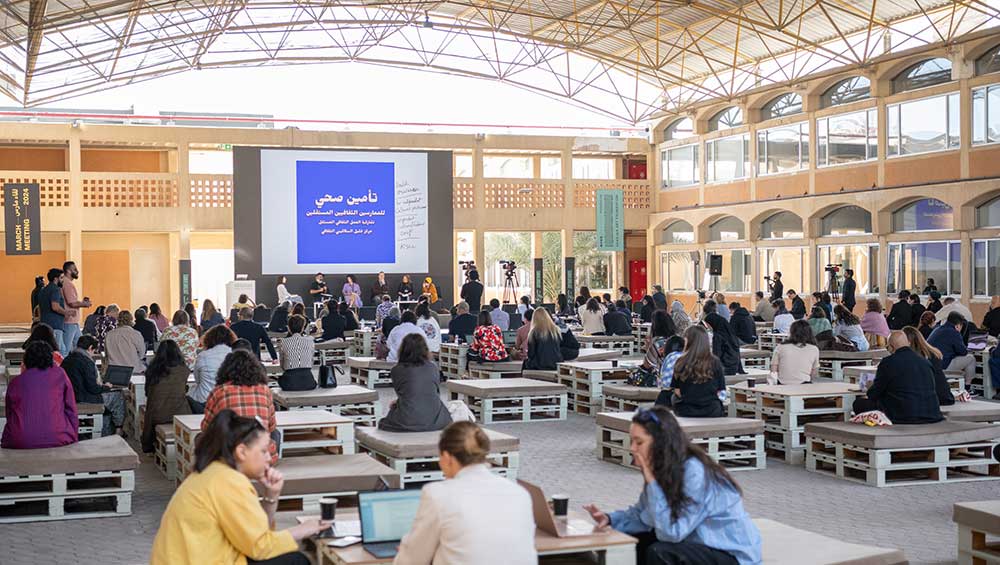
Sharjah Biennial 16 co-curator and independent curator Zeynep Öz moderating the panel, titled Towards Counter-Hegemonic Infrastructures, with Yazan Khalili, Lara Khaldi (The Question of Funding); Joachim Hamou, Nabila Saidi (Trampoline House); Leah Gordon (Ghetto Biennale) at March Meeting. Sharjah Art Foundation, 2024. Photo: Motaz Mawid.
Khalid Bin Mohammed School, Al Manakh, Sharjah
1 – 3 March 2024
by LILLY WEI
The 16th edition of the Sharjah Art Foundation’s annual March meeting took place from 1 to 3 March 2024. Titled Tawashjuat, from the Arabic word meaning the entwining of thoughts, it focused on collectives, collaboratives and community building and on themes of social justice, sustainability, resistance and resilience, and what the roles and forms of art and artists are today. Its opening panel, moderated by Amal Khalaf, one of the five curators tapped for the 2025 Sharjah Biennial, discussed the efficacies of collectives and their increasing numbers while another talked about new takes on indigenousness, sustainability and resistance, moderated by Alia Swastika, another curator for SB2025. The Delhi-based Raqs Media Collective (Jeebesh Bagchi, Monica Narula and Shuddhabrata Sengupta), in what was billed as a lecture performance, discussed their ingenious – or ingeniously discussed – their concept of the “canopy”, defined as a “disposition, a practice of gathering” that would direct us to reformulate our “networks of human associations”.
MM24’s transregional (and beyond), non-European/American perspectives are more crucial than ever to an understanding of our interdependent, conflicted world, one that is tragically even more so in the wake of Gaza, as many people’s thoughts are riveted on the Israel-Hamas war. In the United Arab Emirates, an ally of Israel since the so-called Abraham Accords of 2020 (mediated by the US), anger is mounting, as it is throughout the Arab world and globally, against Israel and the US, with the continuing bombardment and rising death toll of hapless civilians. Inevitably, many of the 80 or so participants (artists, curators, writers and community organisers) alluded to it.
The Palestinian artist and film-maker Emily Jacir said it felt strange to be sipping tea in safety while her people were being “genocided” as she and fellow panellists discussed initiatives and future projects at their respective organisations that focused on dedicated spaces for artists and others in the arts outside mainstream cultural centres. Tariq Ali, the eloquent Pakistani-British political activist, writer, journalist, film-maker and historian, discussed the impact of the dissemination of digitalised information, nearly all of it instantaneous. He cited Cervantes’ Don Quixote as well as the recent self-immolation of the young American airman Aaron Bushnell, in front of the Israeli embassy in Washington as an act of protest, and he claimed that photos in the Guardian of the war in Gaza were at times incendiary, questioning the biases of the western media, to resounding applause, although, of course, it is not only western media that is tilted.
Among several performances was one by the Palestinian artist Jumana Emil Abboud, who walked with stately steps through the seated crowd as she recited a story that was part myth, part folk tale, and part real stories, carrying a brimming basin of water (a dwindling resource) that she periodically placed on the ground, cupping the precious liquid in her hands, and passing it to an onlooker, with instructions to also pass it on, in a ritual of connection that was touching, resonant in its simplicity. There was a reading of poems by Mosab Abu Toha (who also read from the late poet Refaat Alereer, killed during a recent Israeli bombardment) about life under siege in Gaza, who was noticeably, and understandably distracted as he spoke from Cairo, where he had recently fled for refuge.
There was plenty more on offer, such as a tribute to the author Toni Morrison and the inauguration of a fellowship in her name at the Africa Institute (also established by Hoor Al Qasimi, the founder, president and director of the Sharjah Foundation). It featured a screening of a documentary about the late Nobel Prize winner by Timothy Greenfield-Sanders, The Pieces I Am (2019), a delightful two hours spent in the company of the canny, charismatic and, at times, refreshingly outspoken author. The film was visually glamorous, as might be expected from Morrison and Greenfield-Sanders.
An array of exhibitions was also part of the mix. In its second edition, there was the Sharjah Architecture Triennial, The Beauty of Impermanence: An Architecture of Adaptability, curated by Tosin Oshinowo, a Nigerian architect and designer based in Lagos. It explored environmentally gentle ways to resolve housing problems in regions of scarcity, rediscovering and re-implementing traditional means of construction in novel ways as well as restoring disused sites, converting them into public spaces. One project showed the reclamation of a floating structure in Babahoyo, Ecuador, by Natura Futura Arquitectura and Juan Carlos Bamba, the intervention economically modest, upgrading a kind of storage shed into a habitable space for living and working for a local fisherman. At Al Madam, about 30 minutes away, its “ghost village” sited on the dunes is one of a series of modernist habitations that were built in the 1970s for nomadic groups and then abandoned. DAAR –Sandi Hilal and Alessandro Petti – veiled these structures in fabric, underscoring their impermanence. In the meantime, we sat in a carpeted, cushioned concrete tent and had tea as the sun gloriously set.
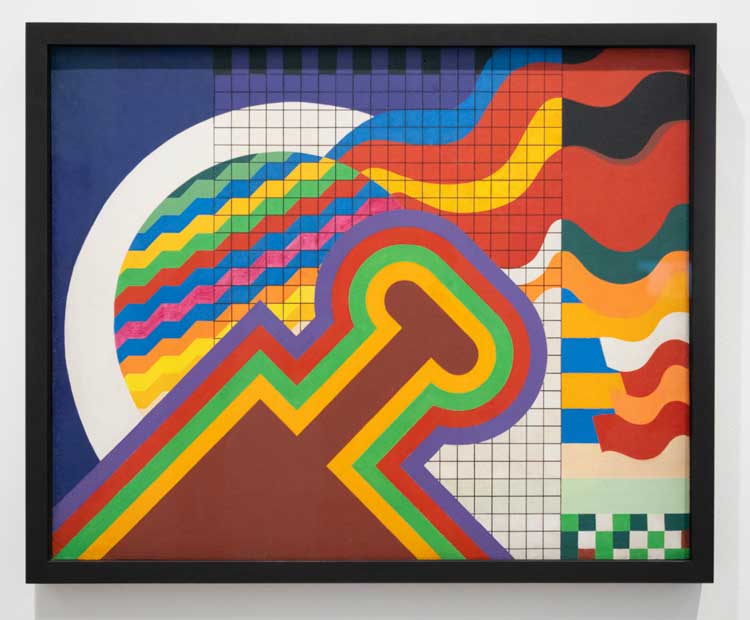
Mohammed Chabâa, Untitled, 1977. Installation view, The Casablanca Art School: Platforms and Patterns for a Postcolonial Avant-Garde (1962–87), Sharjah Art Foundation, 2024. Photo: Motaz Mawid.
There were two other group exhibitions installed about 30 minutes away from the main exhibition venues. One was an engrossing cohort of artists from the Casablanca Art School, a group of modernists who should be better known in the west. It was initiated by the French in the 1920s as a way to maintain cultural control, but by the early 1960s, it came into its own under the directorship of Farid Belkahia. Belkahia, Mohammed Chabâa, and Mohammed Melehi became the heart of the institution, and one significant change they implemented was the admission of women. This concentrated survey tells their story, emphasising the group’s adaptation of Moroccan culture and its exquisite craft traditions to western movements of the 1960s, such as pop, op and hard-edged abstraction, inflected by Zen, and so on, but not as slavish copyists. What they created was their own cosmopolitan, eye-popping, modernist style, challenging colonial concepts. Bold colours and an equally confrontational sense of design make for an assertive presence that is impossible to disregard, the scale grand, for the most part. Even if not, the works still pack a punch. As Toni Mariani, a seminal member who wrote the group’s manifestos said of the 1968 Casablanca Art School students at the Arab League Park Pavilion in Casablanca, there are three goals for the students and themselves: “the understanding and practical knowledge of integrated and applied art”; “the notion of anonymous and collective creation” inspired by the “traditional artistic past”; and the need to seek “a future perspective that would reflect the reality of a country that is being built” in which the artist is called to participate in social and economic reform.
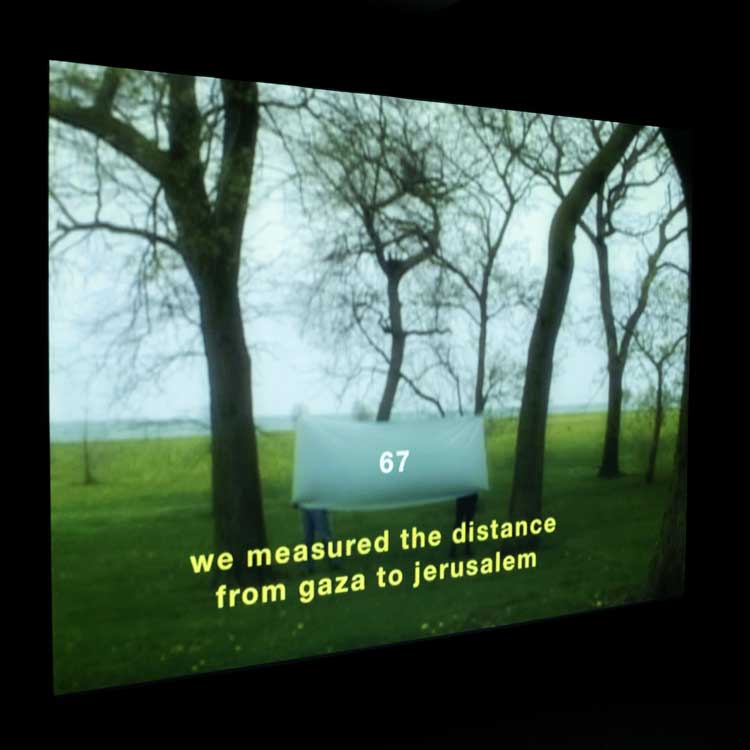
Basma Al Sharif, We Began By Measuring Distance (still), 2009. Commissioned by Sharjah Art Foundation and produced by Sharjah Art Foundation and Ramattan News Agency & Media Services. Installation view, In the eyes of our present, we hear Palestine, Old Al Dhaid Clinic, Sharjah, 2023–24. Photo: Danko Stjepanovic.
Another group show was installed at Al Dhaid in a former clinic and at the Arts Palace. In the Eyes of Our Present, We Hear Palestine, features about 60 Palestinian artists and others from the region, including Jacir, Simone Fattal, Adel Abidin and Mona Hatoum, dedicated to the people of Palestine. One video, We Began by Measuring Distance (2009) by Basma al Sharif, asks what seems a relatively innocent question that has become exponentially less so since it was made: how far is Jerusalem from Gaza? What might be a “pristine, sanitised, cold, emotionless gaze on the territory”, as the artist described it, conjures instead more political and emotional readings about dispossession, contested borders and their grievous consequences.
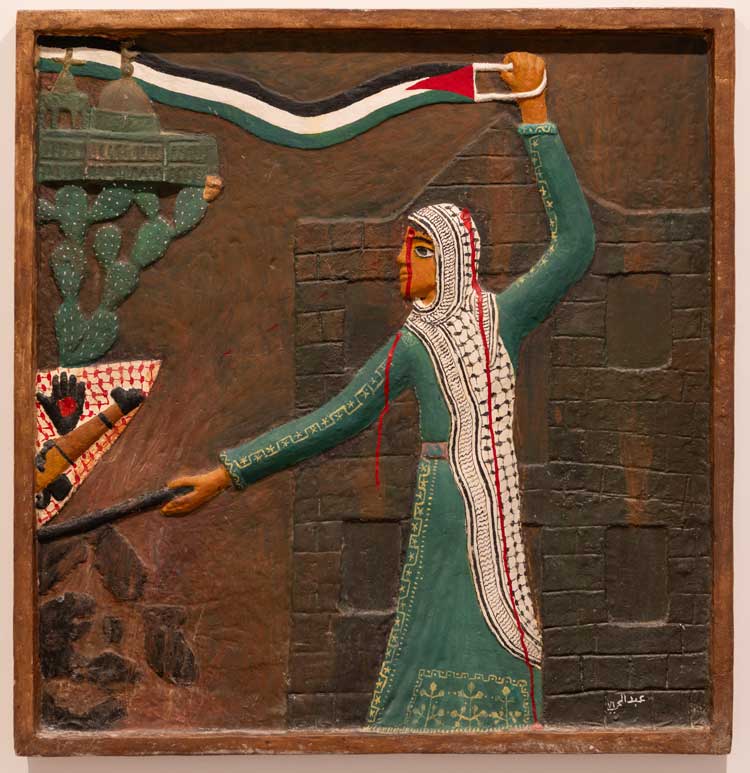
Abdul Hay Mosallam Zarara, The martyr Abu Raja’a Abu Amasheh, 1976. Installation view, In the eyes of our present, we hear Palestine, Arts Palace, Al Dhaid, 2023. Sharjah Art Foundation Collection. Image courtesy of Sharjah Art Foundation. Photo: Shafeek Nalakath Kareem.
Lydda Airport (2009), a short black-and-white video installation (with an elegant model of the airport) by Jacir, is about the British aerodrome built in the 1930s as an important stopover for Britain’s Imperial Airways flights en route from Europe to India, the world’s largest airport for nine years, in the then British Mandate for Palestine. Captured by the Israel Defense Forces in 1948, it was renamed Lod International Airport, then, in 1973, became Ben Gurion International Airport as it is known today, its narrative featuring a missing aeroplane and a missing aviator, Amelia Earhart, who was scheduled to arrive but never did. Jacir deftly weaves together histories that are both speculative and factual. The self-taught Palestinian artist, Abdul Hay Mosallam Zarara, who died in 2020 at 87, was represented in the Arts Palace by a series of vividly coloured, arresting reliefs that record his country’s recent traumatic history. Using acrylic, sawdust and glue, his style naif and extraordinarily effective, he brought to life scenes such as the student uprising in Ramallah as well as the fierce portrayal of its heroes, such as Raja’a Abu Amasheh, believed to be the first female martyr in the Palestinian fight for freedom, blood ribboning downwards from her head, weapon raised.
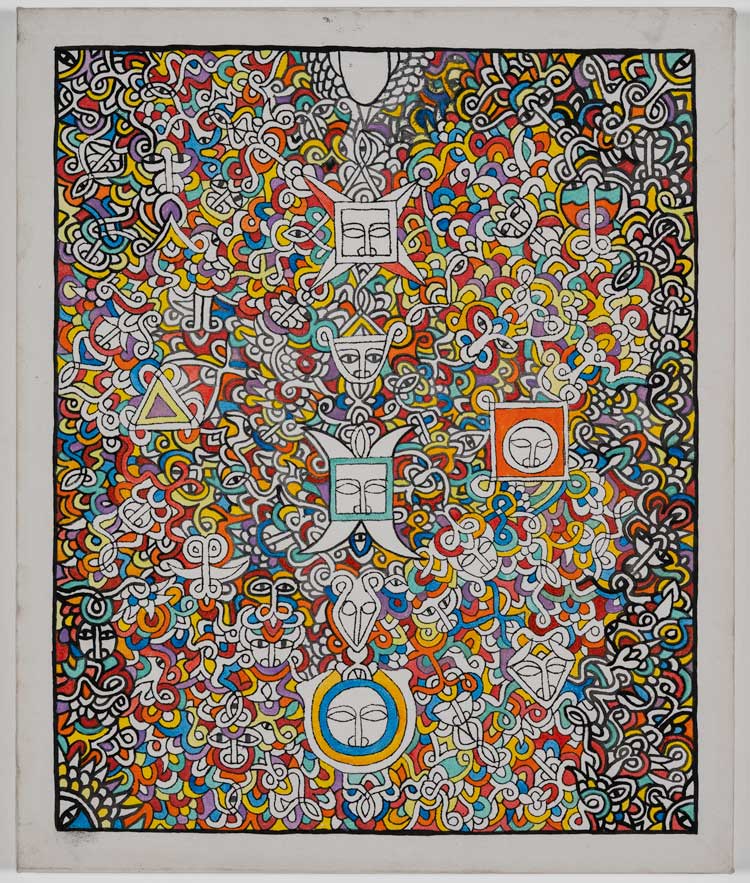
Henok Melkamzer, Untitled, 2023. Image courtesy of Sharjah Art Foundation. Photo: Shanavas Jamaluddin.
Three expansive solo shows are also up at the Foundation. One is by Henok Melkamzer from Ethiopia, a practitioner of telsem, a traditional art form rarely seen in the west that has been practised for centuries in Ethiopia. Based on astrology and religious symbols, drawings and text (they make me think of enlarged tarot cards), they also recall the symbolism and spirituality of the works of Hilma af Klint, who is too often called an abstract artist, even if her work, like Melkamzer’s, is , said the show’s curator, Elizabeth Giorgis, a modernist practice, a living art form and should be seen as such. Melkamzer’s paintings, like Af Klint’s, are not simply geometric abstractions, their remarkable maze-like, densely foliated patterns depict vines, moons and suns, coded representations of the days of the week as well as the months of the year. They act as a kind of calendar, a horoscope of sorts, often commissioned as such, and believed to have healing powers. Melkamzer advised the viewer, in reading telsem, to begin at the centre, where a pair of eyes are present, then proceed outwards. Each vine, he continued, “begins with a word or spiritual concept to depict the complex relationship between colour and the alphabetical form of telsem language”. (The eyes might also have apotropaic power, warding off evil, a belief widespread throughout the region, but usually depicted as a single eye).
Gavin Jantjes: To Be Free! A Retrospective 1970-2023, curated by Salah M. Hassan, director of the Africa Institute, in collaboration with Gilane Tawadros, director, and Cameron Foote, curator, of the Whitechapel Gallery, charts his career from the beginning to the present. Considered one of South Africa’s leading painters and printmakers, Jantjes is also a curator, director, writer, lecturer and activist for human rights, as are many, if not all, the artists showcased in Sharjah. How could they not be, in light of the histories they have inherited? Painting, however, is Jantjes’ great love, and he has returned to it after a two-decade hiatus.
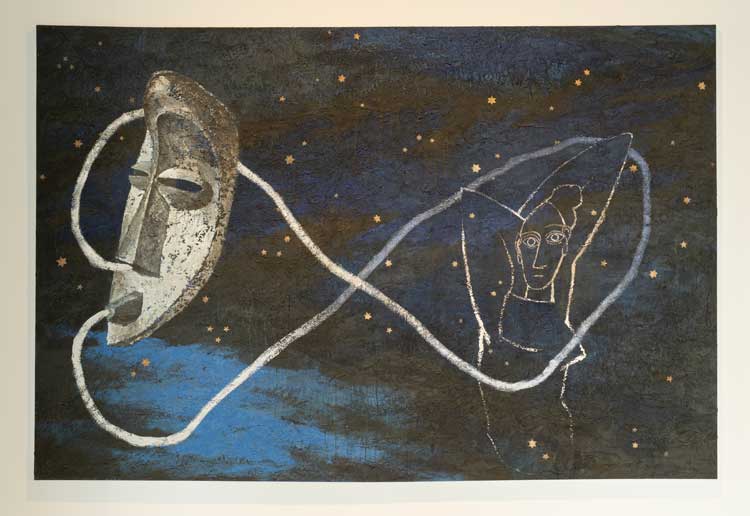
Gavin Jantjes, Untitled, 1989. From Zulu, c1984-90. Installation view, Gavin Jantjes: To Be Free! A Retrospective 1970–2023, Al Mureijah Art Spaces, Sharjah, 2023. Image courtesy of Sharjah Art Foundation. Photo: Shanavas Jamaluddin.
Born in Capetown in 1948, the year apartheid was instituted, he lived most of his life in the UK, Germany and Norway, where he was the director of the Henie Onstad Kultursenter, influencing the arc of African art and the art of the African diaspora through curatorial projects insistently focused on inclusion and diversity, and through frequent lectures and writing. The show is divided into different periods, beginning with the politically motivated, innovative screenprints he made while studying art in Hamburg to the compelling anti-apartheid figurative paintings of the 1970s through the epic Zulu series (he tends to work in series) that is a mix of African and western mythologies and cosmologies, backgrounded by the vast night sky (Zulu meaning the space above) where everyone is free.
One memorable painting depicts a Gabon mask linked by an umbilical cord (looped like an infinity sign) to an outline of a Picasso figure from Les Demoiselles d’Avignon. Jantjes, Hassan emphatically states, does not want African culture to be considered an “appendix” to European aesthetics, refuting the western assumption that Picasso boosted African culture when, in fact, the Spanish master was in its debt. Since 2015, he has begun painting again, but abstractions, his newest work increasingly devoid of any markings except luminous swaths of pastel colours blooming delicately on the support’s surface, like shapeshifting, evanescent cloudscapes, dreamscapes. He said that he has always wanted to just paint, to make artworks, like any other artist, not polemical work about politics, identity, but no one else was doing it so he felt he had to. Now, he feels that he has done his part to “internationalise the canon”; others have taken up the baton and he can, at last, go to his studio and make the work that he wants to make.
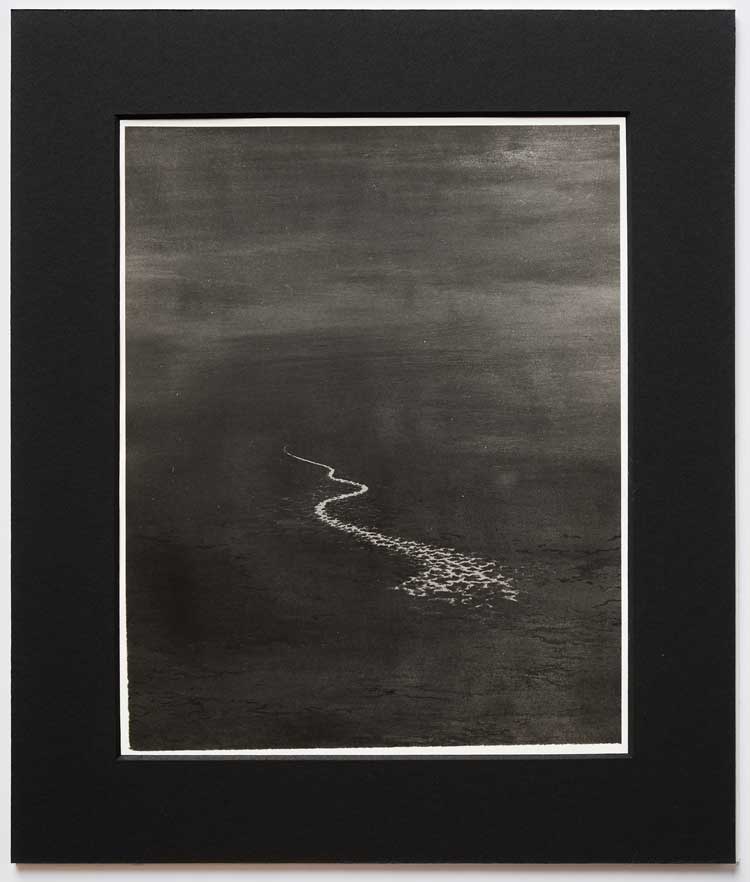
Lala Rukh, River in an ocean: 5, 1993. Image courtesy of the Estate of Lala Rukh and Grey Noise, Dubai.
Lala Rukh: In the Round, is the first comprehensive international exhibition of the late multidisciplinary Pakistani artist, who was also an inspired educator and activist, showing three decades of drawings, prints, photographs, and videos, curated by Natasha Ginwala, a co-curator of SB2025, and Al Qasimi. Not well-known enough outside of Pakistan, where she was a force to be reckoned with, Rukh (1948-2017) spent most of her life in Lahore, although she travelled extensively for her work, to Sri Lanka, India, Myanmar, Nepal, throughout Pakistan and elsewhere. The work shown here, much of it rarely seen, is divided between what might be called her personal oeuvre and her public practice to make a singularly encompassing whole. The political work consists of original posters, videos, archival materials, interviews with her collaborators, and other documents, some personal, accompanying her advocacy for gender equity, social justice and human rights. A founder of Woman’s Action Forum, she was jailed multiple times as she participated in protests against the repressive military dictatorships of Zia ul-Haq and Pervez Musharraf.
Her personal work was reflective, deeply philosophic and poetic, engaged with questions about time, circularity, existence and non-existence. Much of that work is centred on sky, water and land, and is often spare and sombre, the scene barely visible, as we peer into its darkness to make out the shimmer and ripple of water, its ebbs and flow, the movement of the moon across the sky, the curve of a coastline, ruins, all markers of time, of what is here, what disappears, and what returns. Water is a connector that binds us together is a perpetual theme, the darkness creased by glimmers of light, of cosmic energy, functioning as both metaphor and matter, as seen in her River in an Ocean series (1992-93). It is related to her early black-and-white photographic work, and, as Ginwala pointed out, to Vija Celmins’ work, to which Rukh was immediately drawn, encountering it at Documenta 14. Hieroglyphics, an extended series dating from 1995 to 2010, introduced a more calligraphic element into her work, which was linked to music, in particular Hindustani classical music, which was also a profound influence. Her final work was the encompassing Rupak (2016), exhibited first at Documenta 14, consisting of a digital animation and 88 ink drawings that married mark-making, music intervals of silence, and time – ultimately, the only subject.
Sharjah’s March Meetings and its unapologetically serious programmes are not like any other such events. I heard that there were thoughts about making it more voguish, inviting celebrities to come and give it additional lustre and wondered if I had heard correctly. If so, it would become just another stylish event for consumption by the wealthy, the famous, the glamorous and those who thrive in being wealth-, fame- and glamour-adjacent. Surely there are more than enough of such gatherings? I hope it remains the way it is, its voice clear, proclaiming aesthetics as agency, empathy, commitment, action – and possibly lifechanging.
• The Casablanca Art School: Platforms and Patterns for a Postcolonial Avant-Garde (1962 -1987) runs until 16 June 2024; In the Eyes of Our Present, We Hear Palestine runs until 14 April 2024; Henok Melkamzer: Telsem Symbols and Imagery runs until 16 June 2024; Gavin Jantjes: To Be Free! A Retrospective 1970-2023, which ran from 18 November 2023 – 10 March 2024, will be at the Whitechapel Gallery, London, 12 June – 1 September 2024); and Lala Rukh: In the Round runs until 16 June 2024.